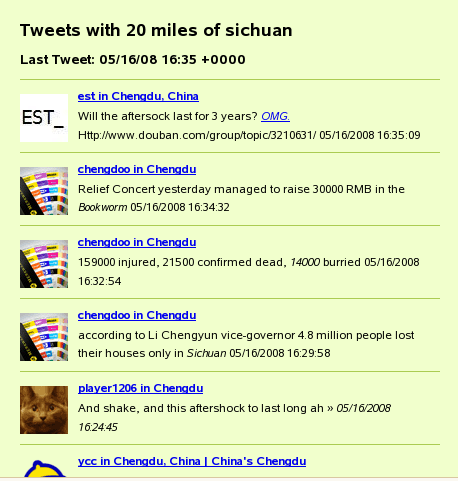Monitoring Current Events with Twitter
Technical Level: Beginner
Type: Practical Applications
 Yesterday Business Week ran an article about how Twitter has impacted how people communicate. Twitter is a “microblogger.” Microblogs are short text updates; similar to blogs, but shorter and without the “frills.” There are other microblogging services such as Jaiku and Pownce, but Twitter is by far the most popular.
Yesterday Business Week ran an article about how Twitter has impacted how people communicate. Twitter is a “microblogger.” Microblogs are short text updates; similar to blogs, but shorter and without the “frills.” There are other microblogging services such as Jaiku and Pownce, but Twitter is by far the most popular.
The power of Twitter is that you can effectively construct your own, unique social network of people whose Twitter messages (called “tweets”) you follow. Another strength is that messages can be posted from anywhere, including mobile devices using SMS. When someone in your network posts a message, your RSS reader, or instant messenger, or cell phone, or whatever you may be using to receive tweets is updated. You could use this to receive helpful real-time tips from other teachers, hear what’s currently happening at the latest teachers’ conference, receive instant alerts to your cell phone, and so on. One student even used it to get himself out of jail.

There are some pretty cool applications for Twitter. TwitterVision and TwitterMap use Google Maps to display tweets while TwittEarth displays tweets on a 3d globe. TwitterTroll and TweetScan are search engines that let you find other Twitterers who share your interests, or search through all the latest tweets. TwitterMail and MessageDance integrate Twitter with your email account, so you can receive and send messages directly from your email box. There are many, many other applications as well.
In all honesty, Twitter really isn’t an application for everyone. Not everyone needs the real-time feel of knowing what’s happening in everyone else’s lives, and there are other ways to connect with other people online. Nevertheless, it can be a useful tool in the classroom. There is even a school-based Twitter-like network designed for students, called Youth Twitter. How do you think you could use Twitter in a lesson or homework assignment?
Robert Scoble, PodTech.net‘s Vice President of Media Development, was watching his Twitter account when the May 12, 2008 earthquake began in the Sichuan Province of China. Some in the area were Twittering about the earthquake while it was happening. Over the next few hours, Twitter was flooded with reports, pictures, and videos from people at the ground level.
TwitterLocal is a useful tool that monitors messages coming from a geographic region. If we want to learn what people are currently saying in Sichuan, we visit the site, type in “Sichuan,” and come up with a list of the latest tweets. Most of them are in Chinese, but a visit to Google Translate fixes that.

After selecting “Chinese to English” and entering the TwitterLocal URL after we found the Sichuan tweets, we have this:

This is a powerful tool for students to feel the riveting effects of international incidents, to find out how they are affecting real people, in their own words, through their own photos and videos, and to be even closer to the scene than watching what the news shows.

[…] in June 13th, 2008 by jreeve in Uncategorized As I demonstrated earlier, TwitterLocal is a great tool to receive updates on events happening around the world. The recent […]